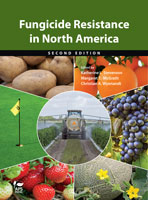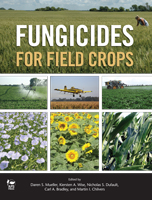Fungicide Resistance in North America, Second Edition
Edited by Katherine L. Stevenson, Margaret T. McGrath, and Christian A. Wyenandt

Fungicides are the primary tools used to manage plant diseases, but they are regularly rendered useless by pathogens’ ability to develop resistance. The development of resistance to fungicides is arguably the greatest challenge to effectively managing plant diseases. A second obstacle in the development and application of fungicides is the constant change in the chemical landscape, as new chemicals are introduced and others are banned.
Fungicide Resistance in North America, Second Edition, is a complete update of the 1988 edition. It describes the current state of fungicide development and management of fungicide resistance in primary pathogens of important agricultural and horticultural crops. Unlike other recently published books on fungicide resistance, this book focuses exclusively on the most significant resistance issues faced by agricultural producers in North America and especially the United States.
This edition is organized into four main sections:
- An overview of the history, science, practice, politics, and management of fungicide resistance
- An updated review of the major fungicide groups—including significant new groups such as succinate dehydrogenase inhibitors (SDHIs), quinone outside inhibitors (QoIs), phenylpyrroles, azonaphthalenes, and carboxylic acid amides—that covers their modes of action, market situations, histories of resistance development, and mechanisms of resistance
- A review of sampling strategies and modern laboratory methods for detecting and characterizing fungicide resistance in plant-pathogenic fungi and oomycetes
- NEW to this edition! Case studies highlighting the historical development, current status, and management of fungicide resistance in key pathogens of major crops, including stone fruits, tree nuts, potatoes, cucurbits, strawberries, rice, turfgrass, and more
Editors Katherine L. Stevenson, Margaret T. McGrath, and Christian A. Wyenandt have extensive experience studying fungicide resistance. Together with nearly 60 contributing authors, they provide the most up-to-date information available on research about the mechanisms of resistance to the major classes of fungicides and strategies for managing resistance. They also provide the knowledge needed to sample appropriately and accurately detect fungicide resistance in pathogen isolates or populations.
Fungicide Resistance in North America, Second Edition, is an extensive and practical tool for agricultural industry and agricultural chemical industry professionals, as well as extension personnel, crop consultants, county agents, farm advisors, and educators and students. Students and readers new to the topic of fungicide resistance will benefit from the glossary of terms provided and from the fundamental discussions of key concepts.
Fungicides for Field Crops
Edited by Daren Mueller, Kiersten Wise, Nicholas Dufault, Carl Bradley, and Martin Chilvers

Fungicides for Field Crops provides an overview of the current knowledge of fungicides and their use on field crops. This comprehensive book, which includes the contributions of 40 professionals from 20 universities and other organizations, combines past knowledge about fungicides with recent developments in the realm of field crop fungicides.
Fungicides for Field Crops highlights the use of fungicides as key tools in the management of important diseases of field crops. Management is presented as a decision-making process—one in which factors as diverse as weather conditions and economics must be considered. Having a more complete understanding of fungicides will inform that decision making and help determine when fungicides should be included as part of a management plan.
Daren S. Mueller and his co-editors have organized the book in a general-to-specific format, making the content accessible to readers of all backgrounds:
-
Parts I, II, and III establish a foundation of knowledge about fungicide use, addressing basic terms and concepts, key factors in decision making, and concerns for fungicide stewardship, respectively.
-
Part IV presents details about using fungicides to manage diseases of 16 field crops. Each crop is treated in a separate section that begins with a discussion of general issues of foliar application and seed treatment and ends with an inclusive table identifying diseases of that crop, including what causes them and how fungicides may be used to treat them.
131 color photographs illustrate disease symptoms and show techniques and enhance the key concepts described in the text.
Fungicides for Field Crops will serve as a valuable resource for agribusiness professionals, researchers and extension personnel, farmers and crop production advisors, and teachers and students. Both current and future agronomists and farmers can rely on this book not only for useful baseline information but also for crop-specific details about the effective and responsible use of fungicides.
Thank you to the sponsors who helped make this book possible.
The American Phytopathological Society thanks the sponsoring companies and organizations that have made it possible to distribute Fungicides for Field Crops at a significantly reduced price, even though the book has been produced with the same high-quality standards as other APS PRESS publications. Because of the support of the following sponsors, this book will be affordable for a broad agricultural audience. We are pleased to partner with these organizations and the book’s authors to publish science-based fungicide information for this important group of crops.